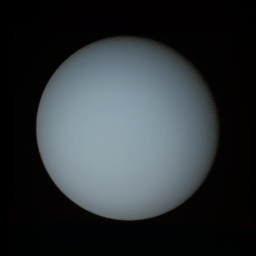
Uranus
Uranus is the seventh planet from the Sun and the third largest
planet in the solar system. Its discovery in 1781 by William
Herschel doubled the known size of the solar system (1). It is
considered to be a gas giant and is covered by a thick atmosphere
consisting mostly of hydrogen and some helium (the amounts of
which are identical to the ratios of the Sun), and it also has
some methane gas above the cloud layers which gives it a
blue-green color (3). There are eleven known rings around Uranus
(3), and unlike the rings surrounding Saturn and Jupiter, these
rings are dark and probably made of methane ice (1).
Data from Voyager 2 suggests that Uranus may be covered by an
ocean of superheated water that may have been formed from melted
comets (1). Because of the extreme pressure from an atmosphere
11,000 km thick, this superheated water does not boil (1). The
ocean is probably 8,000 km thick and covers a rocky, molten core
about the size of Earth (1). Uranus seems to roll around the Sun
on its side because its axis is tilted at 90° (1). This unusual
rotation may be the result of a collision with a planet-sized
body early in Uranus’ history which knocked it on its side
(3).
Uranus is shown to have eighteen moons. Two of them, Miranda and
Ariel, are geologically active and show many fault lines (1). The
high cliffs and winding valleys of Miranda show the partial
melting of its interior, with icy material occasionally floating
to the surface (3). Because Uranus is so far from the Sun (about
2,869 million km), the temperature differences on the summer and
winter sides of the planet do not differ that greatly (on the
cloud tops, the temp. is around -179° C)(3). Uranus has a
diameter of 50,800 km, has 81.01 Earth years in a year, and 16.8
hours in a day (1).
